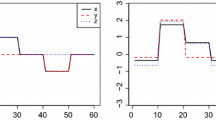Abstract
This paper focuses on the Fréchet distance introduced by Maurice Fréchet in 1906 to account for the proximity between curves (Fréchet (1906)). The major limitation of this proximity measure is that it is based on the closeness of the values independently of the local trends. To alleviate this set back, we propose a dissimilarity index extending the above estimates to include the information of dependency between local trends. A synthetic dataset is generated to reproduce and show the limited conditions for the Fréchet distance. The proposed dissimilarity index is then compared with the Fréchet estimate and results illustrating its efficiency are reported.
Access this chapter
Tax calculation will be finalised at checkout
Purchases are for personal use only
Preview
Unable to display preview. Download preview PDF.
Similar content being viewed by others
References
GEARY, R.C. (1954): The contiguity ratio and statistical mapping. The Incorporated Statistician, 5/3, 115–145.
VON NEUMANN, J. (1941): Distribution of the ratio of the mean square successive difference to the variance. The Annals of Mathematical Statistics, 12/4.
VON NEUMANN, J., KENT, R.H., BELLINSON, H.R. and HART, B.I. (1942): The mean square successive difference to the variance. The Annals of Mathematical Statistics. 153–162.
FRÉCHET, M. (1906): Sur quelques points du calcul fonctionnel. Rendiconti del Circolo Mathematico di Palermo, 22, 1–74.
GODAU, M. (1991): A natural metric for curves — computing the distance for polygonal chains and approximation algorithms. In Proc. 8th Sympos. Theor. Aspects of Comp. STACS, LNCS 480, 127–136.
ALT, H. and GODAU, M. (1992): Measuring the resemblance of polygonal curves. In Proc. 8th Annu. ACM Sympos. Comput. Geom. 102–109.
EITER T. and MANNILA, H. (1994): Computing Discrete Fréchet distance, Technical Report CD-TR 94/64, Christian Doppler Laboratory for Expert Systems. TU Vienna, Austria.
CHOUAKRIA-DOUZAL, A. (2003): Compression Technique Preserving Correlations of a Multivariate Temporal Sequence. In: M.R. Berthold, H-J Lenz, E. Bradley, R. Kruse, C. Borgelt (eds.). Advances in Intelligent Data Analysis, 5, Springer, 566–577.
Author information
Authors and Affiliations
Editor information
Editors and Affiliations
Rights and permissions
Copyright information
© 2006 Springer-Verlag Berlin · Heidelberg
About this paper
Cite this paper
Chouakria-Douzal, A., Nagabhushan, P.N. (2006). Improved Fréchet Distance for Time Series. In: Batagelj, V., Bock, HH., Ferligoj, A., Žiberna, A. (eds) Data Science and Classification. Studies in Classification, Data Analysis, and Knowledge Organization. Springer, Berlin, Heidelberg . https://doi.org/10.1007/3-540-34416-0_2
Download citation
DOI: https://doi.org/10.1007/3-540-34416-0_2
Publisher Name: Springer, Berlin, Heidelberg
Print ISBN: 978-3-540-34415-5
Online ISBN: 978-3-540-34416-2
eBook Packages: Mathematics and StatisticsMathematics and Statistics (R0)




